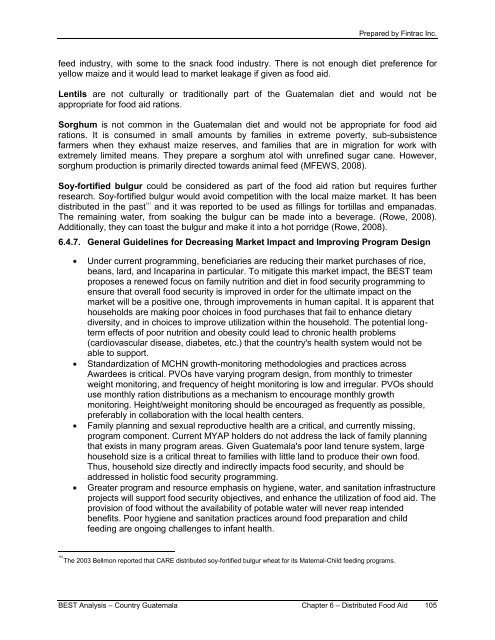usaid office of food for peace guatemala bellmon estimation
usaid office of food for peace guatemala bellmon estimation
usaid office of food for peace guatemala bellmon estimation
You also want an ePaper? Increase the reach of your titles
YUMPU automatically turns print PDFs into web optimized ePapers that Google loves.
Prepared by Fintrac Inc.<br />
feed industry, with some to the snack <strong>food</strong> industry. There is not enough diet preference <strong>for</strong><br />
yellow maize and it would lead to market leakage if given as <strong>food</strong> aid.<br />
Lentils are not culturally or traditionally part <strong>of</strong> the Guatemalan diet and would not be<br />
appropriate <strong>for</strong> <strong>food</strong> aid rations.<br />
Sorghum is not common in the Guatemalan diet and would not be appropriate <strong>for</strong> <strong>food</strong> aid<br />
rations. It is consumed in small amounts by families in extreme poverty, sub-subsistence<br />
farmers when they exhaust maize reserves, and families that are in migration <strong>for</strong> work with<br />
extremely limited means. They prepare a sorghum atol with unrefined sugar cane. However,<br />
sorghum production is primarily directed towards animal feed (MFEWS, 2008).<br />
Soy-<strong>for</strong>tified bulgur could be considered as part <strong>of</strong> the <strong>food</strong> aid ration but requires further<br />
research. Soy-<strong>for</strong>tified bulgur would avoid competition with the local maize market. It has been<br />
distributed in the past 151<br />
and it was reported to be used as fillings <strong>for</strong> tortillas and empanadas.<br />
The remaining water, from soaking the bulgur can be made into a beverage. (Rowe, 2008).<br />
Additionally, they can toast the bulgur and make it into a hot porridge (Rowe, 2008).<br />
6.4.7. General Guidelines <strong>for</strong> Decreasing Market Impact and Improving Program Design<br />
Under current programming, beneficiaries are reducing their market purchases <strong>of</strong> rice,<br />
beans, lard, and Incaparina in particular. To mitigate this market impact, the BEST team<br />
proposes a renewed focus on family nutrition and diet in <strong>food</strong> security programming to<br />
ensure that overall <strong>food</strong> security is improved in order <strong>for</strong> the ultimate impact on the<br />
market will be a positive one, through improvements in human capital. It is apparent that<br />
households are making poor choices in <strong>food</strong> purchases that fail to enhance dietary<br />
diversity, and in choices to improve utilization within the household. The potential longterm<br />
effects <strong>of</strong> poor nutrition and obesity could lead to chronic health problems<br />
(cardiovascular disease, diabetes, etc.) that the country's health system would not be<br />
able to support.<br />
Standardization <strong>of</strong> MCHN growth-monitoring methodologies and practices across<br />
Awardees is critical. PVOs have varying program design, from monthly to trimester<br />
weight monitoring, and frequency <strong>of</strong> height monitoring is low and irregular. PVOs should<br />
use monthly ration distributions as a mechanism to encourage monthly growth<br />
monitoring. Height/weight monitoring should be encouraged as frequently as possible,<br />
preferably in collaboration with the local health centers.<br />
Family planning and sexual reproductive health are a critical, and currently missing,<br />
program component. Current MYAP holders do not address the lack <strong>of</strong> family planning<br />
that exists in many program areas. Given Guatemala's poor land tenure system, large<br />
household size is a critical threat to families with little land to produce their own <strong>food</strong>.<br />
Thus, household size directly and indirectly impacts <strong>food</strong> security, and should be<br />
addressed in holistic <strong>food</strong> security programming.<br />
Greater program and resource emphasis on hygiene, water, and sanitation infrastructure<br />
projects will support <strong>food</strong> security objectives, and enhance the utilization <strong>of</strong> <strong>food</strong> aid. The<br />
provision <strong>of</strong> <strong>food</strong> without the availability <strong>of</strong> potable water will never reap intended<br />
benefits. Poor hygiene and sanitation practices around <strong>food</strong> preparation and child<br />
feeding are ongoing challenges to infant health.<br />
151<br />
The 2003 Bellmon reported that CARE distributed soy-<strong>for</strong>tified bulgur wheat <strong>for</strong> its Maternal-Child feeding programs.<br />
BEST Analysis – Country Guatemala Chapter 6 – Distributed Food Aid 105

















